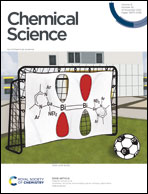Electrochemically selective double C(sp2)–X (X = S/Se, N) bond formation of isocyanides†
Abstract
The construction of C(sp2)–X (X = B, N, O, Si, P, S, Se, etc.) bonds has drawn growing attention since heteroatomic compounds play a prominent role from biological to pharmaceutical sciences. The current study demonstrates the C(sp2)–S/Se and C(sp2)–N bond formation of one carbon of isocyanides with thiophenols or disulfides or diselenides and azazoles simultaneously. The reported findings could provide access to novel multiple isothioureas, especially hitherto rarely reported selenoureas. The protocol showed good atom-economy and step-economy with only hydrogen evolution and theoretical calculations accounted for the stereoselectivity of the products. Importantly, the electrochemical reaction could exclusively occur at the isocyano part regardless of the presence of susceptible radical acceptors, such as a broad range of arenes and alkynyl moieties, even alkenyl moieties.



 Please wait while we load your content...
Please wait while we load your content...